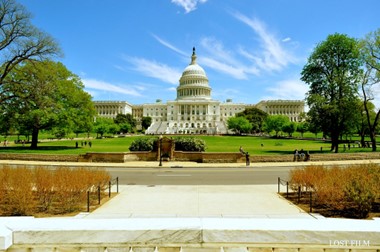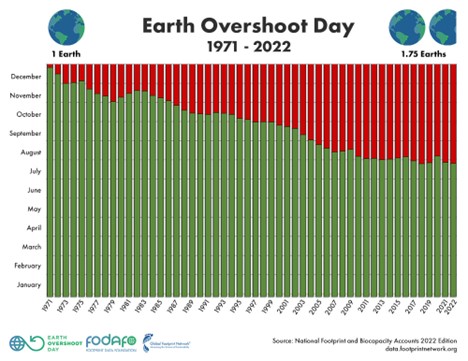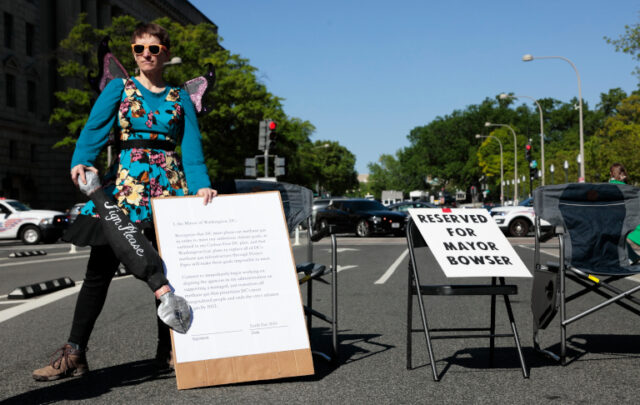Official Washington is all aflutter over whether Congress should raise the ceiling on U.S. government debt. But this is not the most pressing debt question our country faces.

Capitol Hill: Home to skewed priorities (CC BY-NC-ND 2.0 ), Jack Parrott)
To see why, step back and enlarge the frame. A new question emerges: Why would Congress create an artificial and wholly unnecessary debt crisis while ignoring a far more dangerous and decidedly real debt trap? I speak of our ballooning ecological debt, the chronic overdrawing of nature’s goods and services to feed the voracious appetite of our growing economy. Ecological debt has mushroomed steadily for decades and is far riskier than default by the U.S. Treasury. This debt needed capping long ago, but virtually no one in official Washington calls for a ceiling on ecological debt, which is arguably the most fundamental way we live beyond our means.
Meanwhile, ecological debt gallops ahead relentlessly, driven by the growth-centered engine at the heart of our economy. Default on ecological debt is a threat of the greatest gravity; it would make a Treasury default look about as worrisome as an unbalanced checkbook. If Congress is concerned about ledgers that don’t square, it should focus first on the ecological debt of the nation and the world.
People speak of ecological debt in different ways, but let’s consider two, one focused on ecology, the other on nations and their people.
Ecological Overdrafts
We incur ecological debt every time we withdraw resources faster than they are replenished: when farmers pump groundwater faster than the rate of recharge, when forest harvest outpaces regrowth, and when fish catch exceeds the rate of fish reproduction. Indeed, every environmental problem represents an ecological overdraft of some sort. Open today’s paper and count the stories of ecological debt, even if the articles never use the term. Deforestation, water scarcity, species losses, soil erosion—each is an overuse of a natural asset, an excess withdrawal made temporarily possible by dipping into nature’s reserves. Even climate change and polluted rivers involve a component of ecological debt: It’s the amount by which pollutants loaded into the atmosphere and waterways exceeds the capacity of those natural sinks. In sum, while Congress often complains that our economy is dangerously debt-based (financially), in truth the economy is more perilously founded on ecological debt.
Many ecological debts can be paid by replenishing overspent stocks, and for the sake of humanity and nature, policymakers should make every effort to do so. But debt payment is rarely a priority. Instead, we take nature’s plenty for granted and assume that a resource or ecosystem service is essentially infinite. (Pause a moment and consider the absurdity of that belief: that forests cannot be eliminated, reservoirs cannot be emptied, and the atmosphere cannot be overloaded, because each is infinitely large. That’s essentially the stance that policymakers, the media, and much of the public reflexively take.)
Then there are the ecological assets that will never be recovered—wasted nonrenewable resources such as copper, or species driven to extinction. These debts are unpayable and must be written off as total losses.
Deep and Worsening

Meanwhile, the repayable portion of our ecological debt is enormous and accumulating rapidly. The Global Footprint Network (GFN) has for decades tracked the use of many renewable resources relative to their growth—for example, the number of trees cut compared to new trees grown. For all of human history prior to 1970, the world’s people took from nature each year less than she generated. But in 1970, we consumed the planet’s supply of newly generated renewable resources by December 30th. Thus, for the first time, humanity’s consumption of renewable resources exceeded Earth’s output (slightly, by one day’s consumption). We did this by tapping nature’s stock for a little extra—by borrowing from nature. This was humanity’s first experience with ecological debt at the global level.
Since then, what GFN calls “Earth Overshoot Day”—the day when human consumption of renewable resources exceeds what Earth can produce for the year—has arrived ever earlier (the red portion in the graph). In 2022, Overshoot Day fell on July 28, meaning that for the remaining five months of 2022 humanity borrowed from nature to cover its consumption of renewable resources.
Imagine your annual salary carrying you only through the end of July. Now picture yourself signing for a loan to carry you through the rest of the year. Surely the stress of this weighty debt would seize your attention and spur action! Yet Congress appears hardly to notice the ecological equivalent of humanity living well beyond our means.
Default on our ecological debt would be calamitous. It would mean acceptance of ecosystem collapses, accelerated extinctions, blistering warming, and expansion of deserts, to name a few consequences. If you doubt this, ask the people of Cape Town, who came within weeks of draining their reservoirs in 2018. No, better: Ask the people of Chennai, India, a city with nearly 50 percent more rainfall than London, where four reservoirs actually did run dry in 2019, requiring that water be trucked and railed in, and that residents queue up with plastic containers to collect limited water rations. Residents of Chennai would surely advise that ignoring ecological debts eventually results in a direct hit to lives, livelihoods, and entire economies.
Obligations to Supplier Countries
Another kind of ecological debt is the obligation of wealthy nations to compensate low-income countries for our excessive consumption. Cheap resources from developing countries are what enable the rich-nation appetite for materials and energy. Moreover, corporations often base their extractive operations in developing countries to avoid stricter and more expensive environmental standards in rich ones. This dynamic, known as the “pollution haven hypothesis,” is controversial, with scholars landing on both sides of the debate. But a 2021 study of the topic—the first to analyze the environmental impact of the component parts of supply chains in North-South trade—found that “high-income countries offshore their emissions to low-income countries by outsourcing only the dirty production stages instead of the entire production process.” The study essentially confirmed that less powerful nations are the dumping grounds that make possible the cleaner and more affluent lifestyles of wealthy countries.

Developing countries serve as industrial dumping grounds for the Global North. (CC BY 2.0 by eutrophication&hypoxia)
The unjust practices covered by the pollution haven hypothesis include the carbon emissions and water and air pollution associated with extractive activities and the export of toxic waste to less powerful nations, among others.
How Much do We Owe?
Estimates of the value of our ecological debt to other nations vary widely, depending on the scope of inquiry. But our climate debt alone is estimated by the Center for Global Development to be in the tens of trillions of dollars. Add to the climate bill the cost of polluted air and water, lost species, damage to ecosystem services, and a host of other environmental ills, and the total debt to other countries climbs much higher.
Ecological debt of both kinds carries a moral weight that demands our attention and response. In his 2021 spring address to the World Bank Group and International Monetary Fund, Pope Francis noted, “We are, in fact, in debt to nature itself, as well as the people and countries affected by human-induced ecological degradation and biodiversity loss,” and he called on the assembled economists and financiers to help develop methods for calculating wealthy nations’ ecological debt. This might be critiqued as the fox guarding the henhouse, but at a minimum Francis’ call suggests that ecological debt is an actionable concept, not just an abstract or metaphorical one. Congress, take note.
Paying it Down
Tally in hand, debt payment can begin. Funds transfers will be a large part of the payment response, but policymakers will need to target assistance to habitat restoration efforts, re-wilding initiatves, and creation of preserves. The ambition of these efforts must match the debt incurred.
Nearly a decade ago, the biologist E.O. Wilson made famous the call to set aside fully half of the planet for nature, a strategy that would allow species and ecoystems to recover on a scale that builds resilience. The proposal, audacious when first proposed, may be gaining traction. At the United Nations Biodiversity Conference (COP-15) last December, the final agreement called for setting aside 30 percent of the planet for nature by 2030.
Although far short of the 50 percent protected area proposed by Wilson, the COP15 agreement represents a substantial increase in the shares of land (nearly 17 percent) and oceans (nearly 8 percent) considered protected in the 2020 Protected Planet report. And of course governments can always treat the COP-15 goal as a down payment, and build upon it.
The Bottom Line
By either measure of debt—ecological or financial—our arrears are gargantuan. We owe future generations and other species nearly an extra Earth‘s worth of biodiversity, and we owe developing countries at least tens of trillions of dollars in compensation. This reality spawns two immediate conclusions: 1) the economies that produced such enormous debt are fundamentally flawed and unsustainable, and 2) balancing the ecological books will require constructing economies wholly different from the current ones. That alternative is the steady state economy, an economy nested in nature.

Steady state economies: the only economic model truly supportive of nature. (CC BY-NC-SA 2.0 , gelinh)
Transitioning to a steady state economy requires powering down our economy to a size that fits within the ecological boundaries set by nature. This means establishing an ecological debt ceiling, a level of resource use that does not deplete the ecological base that supports all human life and activity.
Members of Congress need to abandon their childish preoccupation with an artificial fiscal debt crisis. They should focus on a far more important responsibility: paying the debt we owe to ourselves, to nature, and to supplier countries.





